2013.02.16 15:49
16 February
Patrik Schmacher: The term 'Parametricism' implies that all elements of architecture are becoming parametrically malleable and thus adaptive to each other and to the context.
Luhmann refers to architecture within his The Art of Society where he theorizes art as a self-referential social system. He subsumes architecture within the art system. This treatment of architecture has to be rejected today. It reflects the traditional classification of architecture among the arts. It is one of the central, historical theses of the theory of architectural autopoiesis that this treatment of architecture under the umbrella concept of 'the arts' is long since an anachronism--at least since the refoundation of the discipline of Modern architecture during the 1920s.
Patrik Schumacher, The Autopoiesis of Architecture, p. 146.
Modernism: Modernist architecture was faced with a veritable explosion of the problem domain as full blown industrialization was followed by social revolution which--for the first time--introduced the masses as new clients for architecture. This explosive expansion of design tasks was paralled by new solution spaces: the ready availability of new construction methods (steel and reinforced concrete), as well as the emergence of the new design resources that were delivered by abstract art opening up a hitherto unimagined realm of creative formal invention.
Patrik Schumacher, The Autopoiesis of Architecture, pp. 291-2.
I can't tell yet if The Autopoiesis of Architecture is written parametrically, but it is certainly worthwhile when read parametrically.
2013.02.28 11:49
Thread Central
Still spot reading (indexed passages, whole chapters) The Autopoiesis of Architecture, both volumes, and beginning to wonder whether these books will prove to be highly influential in subtle ways that don't even relate specifically to parametrics. The books cover a large range of topics, all delivered in condensed form, and it is this condensification that I think manifests the high potential for longevity of influence.
Bilocation can be fun. Inspiring, even.
Durand Revisted Parametrically--sometime in the 21st century?
2013.03.13
2013.03.14
Noticed a provocative similarity between
2013
Noticed a provocative similarity between one the collages produced by Libeskind* while a student at Cooper Union (c. 1969) and the plan for La Villette by Koolhaas and Zenghelis (1982).
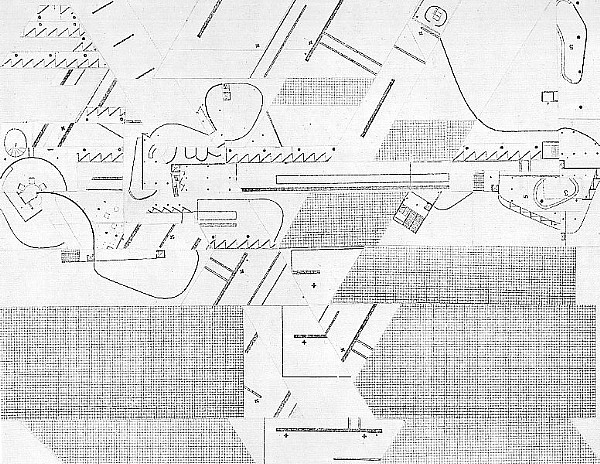

Provocative in the sense of now mentally overlapping the two design strategies, kind of like dimensionally enhancing the already multiple choices.
*Libeskind uses bits of Barcelona Pavilion, Tugendhat House (both Mies), Carpenter Center, Palais des Congres (both Le Corbusier).
Coincidently read this in The Autopoiesis of Architecture early this morning:
"...and Rem Koolhaas's Delirious New York celebrating Manhattan's 'culture of congestion' and its 'critical paranoid method' of radical programmatic and stylistic juxtaposition. The phenomena that Koolhaas found in New York--congestion and random juxtaposition--were violating the prevailing Modernist principles." (p. 130)
It seems that "congestion and random juxtaposition--were violating the prevailing Modernist principles" could be said for Libeskind's collage as well.
Maybe later today I'll take the La Villette plan and cut-and-paste it like a Libeskind collage.
While thinking of all this, I was reminded of something I wrote 2004.05.18 (for sure subliminally influenced by Koolhaas): "I like the list; like chapters, like lessons, like evolutionary stages, like different floors of a building I'd love to design, like a row of restaurants while you're perpetually hungry."
And finally, like the La Villette plan is the section of the New York Athletic Club flipped down, that tower for Dubai is an older Arab settlement flipped up.
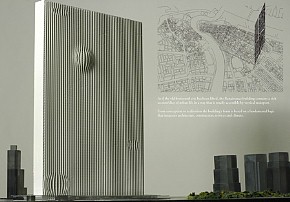
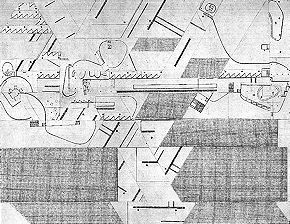
Would the Libeskind collage make for an interesting building section?
| |
2013.05.14 21:31
14 May
Three other variations on the theme remain for special comment. This trio have in common the idea, typical of synthetic eclecticism, of creating a new building type by combining elements from two of the most famous buildings of antiqity, the Parthenon and the Pantheon. Thus, perhaps, something new is created, something taking of the universally acknowledged excellences of these archetypes. It is too much to say that the combinations surpass either of the paradigms, but it cannot be denied that the resulting contrasts of form are productive of novel and provocative aesthetic effects. Similar juxtapositions of well-known and heavily associated forms were a commonplace in the projects of imaginative architects at this time, such as Boullee, Gilly, and Valadier; and Robert Mills proposed a combination of a Doric colonnade and an obelisk for the Washington Monument.
Carroll L. V. Meeks, "Pantheon Paradigm" (JSAH: 1960.12, 142).
Aldo Ross's Modena cemetery design of 1971 has been one of the most widely discussed architectural projects of the past decade. Now under construction, on the basis of a revised plan of 1976, Rossi's cemetery demonstrates his use of established architectural types, in unexpected combinations, to convey specific ideas about architecture and life.
Some critics, such as Manfredo Tafuri, have taken the view that the meaning of Rossi's design cannot be verbalized. This articale seeks to demonstrate that the oposite is the case. Here, Rossi's sources and writings are explored in tandem, in order to unravel the complex message contained in his cemetery design. In particular, Rossi's debts to Piranesi, Boullee, Loos, Hannes Meyer, Le Corbusier, and de Chirico are discussed.
Eugene J. Johnson, "What Remains of Man--Aldo Rossi's Modena Cemetery" (JSAH, 1982.3, 38).
Eternal Wrest in Pieces
just thought of that while typing the above.
His book is designed as a megastructure, and we all know now their fate today.
Read together, they avail us of the opportunity to be placed both "within" and "without" at one and the same time, which none of the books on their own would allow.
Chris Fawcett, "The Rites of Criticism" (JSAH, 1980.5, 155-6).
He asserts that as early as the 18th century, Piranesi discerned that a wholly organized world is not a paradise but a nightmare. The full consequences of these contradictions, however, were not worked out until the 20th century.
I trust that Tafuri's advise will be similarly ignored.
The great value of Architecture and Utopia lies not in its political prescriptions but in its wealth of insights into the relationship between architecture and social theory since the Enlightment. Therein also lies its great frustration. The book touches on a bewildering variety of topics from Abbe Laugier to Andy Warhol until it seems less like a sustained argument than a series of brilliant asides. The pace is a rapid as the scene in Godard's "Breathless" in which the characters race each other through the galleries of the Louvre.
Robert Fishman, "Utopia and its Discontents" (JSAH, 1980.5, 153-5).
2013.05.16 11:32
FRANK GEHRY AT WORK on View in New York City
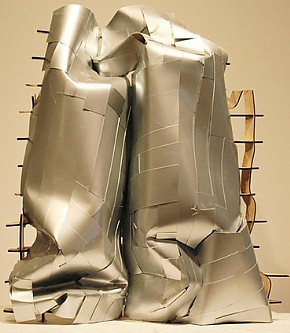
Remember Eisenman's September 2002 proposal for new towers adjacent Ground Zero?
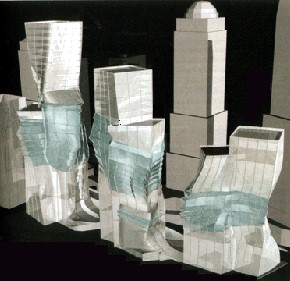
I don't have any books on Gehry post 1999, so I still have to investigate what Gehry was doing circa 2002. Actually, there is a more recent book I can get from the Free Library. I have a feeling that Eisenman was ahead of Gehry with regard to the whole crumbling/falling-down look/form.
Will history come to acknowledge the events of 9-11 as having a significant effect on early 21st century architectural form?
| |
2013.05.16 21:19
FRANK GEHRY AT WORK on View in New York City
I used the word crumble (with a 'b'), and you used the word crumple (with a 'p'), and they are not the same thing. Yes, the crumple (ie, scrunch together) has been a part of Gehry's design vocabulary since the late nineties, but the crumble (ie, erode, fall apart) is much more recent in Gehry's work. It might well be significant that Eisenman's 2002 design is a combination of crumple and crumble.
2013.05.23 09:59
What are the cultural ingredients of architecture today?
Is FACTUM arte a possible proto-type of future architectural business? Like the architect could spec Duchamp Fountains for all the men's rooms to add some culture to the act of purgation.
Is the real value then in the 3D data file that tells the 3D printer what to do?
(Although I very much doubt I'll personally get to see it, nevertheless) Could someone that inherits all of Quondam's 2D and 3D file data someday in the future decide to 3D print it all out and thus make an actual Museum of Architecture?!?
note to self: rewrite my will to make sure I bequeath all of Quondam's data to an entity that has the money and operation to actually turn Quondam into a reality. I'm sure Disney could do it, but it would be funny to leave it all to China. Why am I leaning toward Dubai?
Next time someone asks me what I do, I'll tell them I'm very busy becoming posthumously famous.
2013.07.15 13:34
Why is everyone bashing OMA and Rem Koolhaas?
Since 2009.11.20, I like how OMA/Rem Koolhaas's Quartied les Halles (2003-04) helps me to imagine Quaestio Abstrusa Background No. 191 (2001.04.28) in 3-dimensional architectural form.
2013.07.18 13:13
18 July
...some Borges, some Capote, some Quondam
"A labyrinth of symbols," he corrected. "An invisible labyrinth of time."
"...I questioned myself about the ways in which a book can be infinite. I could think of nothing other than a cyclic volume, a circular one. A book whose last page was identical with the first, a book which had the possibility of continuing indefinitely."
I have taken on the mysterious duty of reconstructing literally his spontaneous work. My solitary game is governed by two polar laws. The first permits me to essay variations of a formal or psychological type; the second obliges me to scarifice these variations to the "original" text and reason out this annihilation in an irrefutable manner...
Some years earlier, Lillian Ross had published Picture, her account of the making of a movie, The Red Badge of Courage; with its fast cuts, its flash forward and back it was itself like a movie, and as I read it I wondered what would happen if the author let go of her hard linear straight-reporting discipline and handled her material as if it were fictional--would the book gain or lose?
...I wonder what would happen if the architect let go of his straight-curating discipline and handled the material as if it were fictional--would the museum gain or lose?
2013.08.17 10:17
17 August
2008.08.17 12:03 I just looked up trend spotting on google because that's what current architectural theory/history wants to be good at but isn't, and followed a link and then another link, and there it was, the conceptual model of my next building...
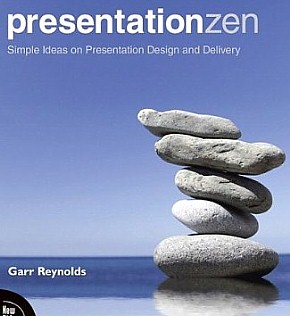
Finally got around to it 2013.07.18...
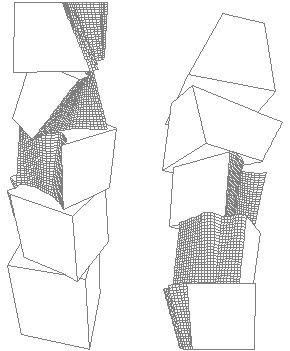
| |
2013.08.17 14:31
17 August
To be honest, the product was not actually created with the above concept (image) directly in the fore of my mind. Seeing the presentationzen image this morning quickly reminded me of what I was doing a month ago, and then said to myself, "Aha, there's the connection!"
What impressed me about the stacked distorted 'cubes' (as tall as the quondam World Trade Center towers) was their distinct look of instability when seen from street level. An visual instability, even though the 'cubes' are stacked flatly atop each other, created by the various cantings of the various 'cube' sides.
2013.08.18 11:17
17 August
...who knows how this design might develop. Right now it's the product of about an hour's worth of design (play), and still the most unlikely of buildings, if not plain impossible. I might change the scale (x,y,z) completely and develop the design as a 10 or 15 storey building--a Pradada HQ or something (telling the client it's a stack of fancy hat boxes). Just keepin' it virtual.
Now I'm thinking of starting a whole new set of buildings with the distorted 'cubes' also rotated but stacked side-by-side.
2013.08.18 17:35
17 August
...citing Hejduk's Wall House 2 introduces a very interesting associational trope. Very interesting, and even opens up a whole new area of play. It also got me thinking of an enigmatic set of ten 'buildings' within Hejduk's second to last book, Adjusting Foundations (1995), here's two:
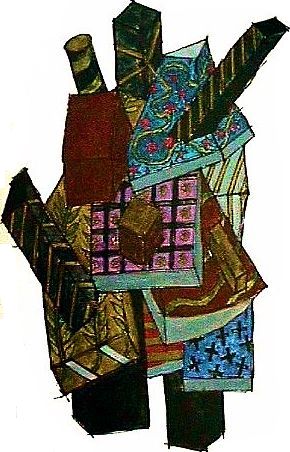
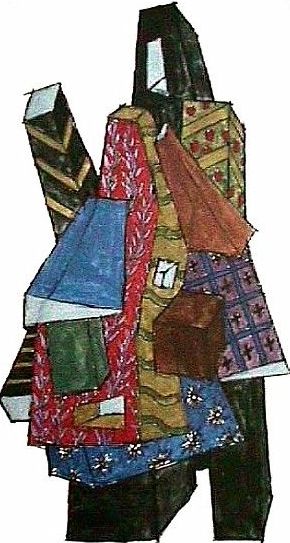
These buildings are not labeled (as to what they might be), nor are they even listed in the book's table of contents. Stacks of extra fancy hat boxes?!? A presence of architectural presents?!?
|